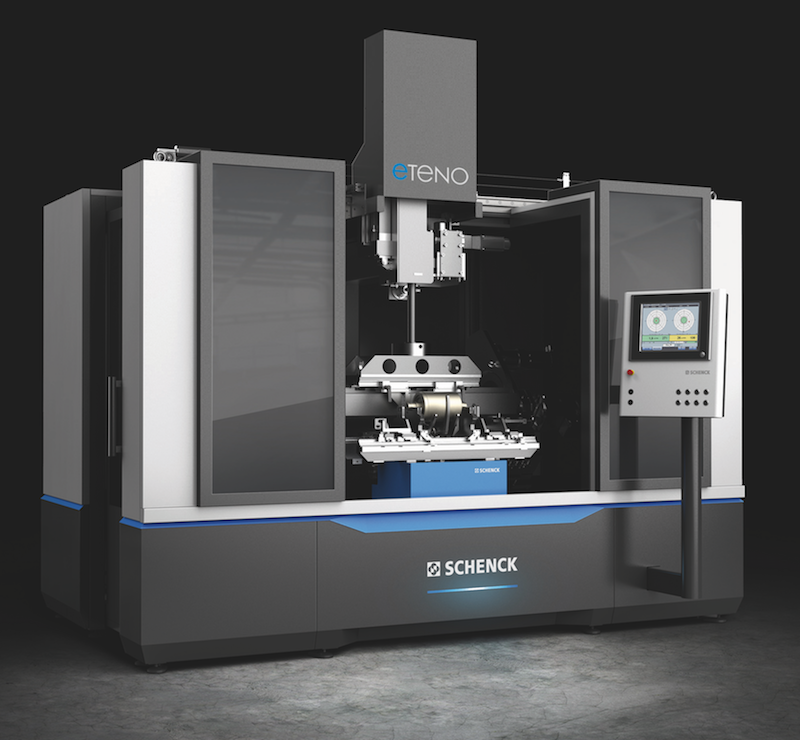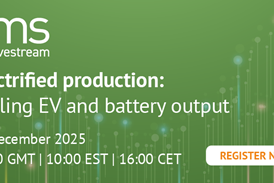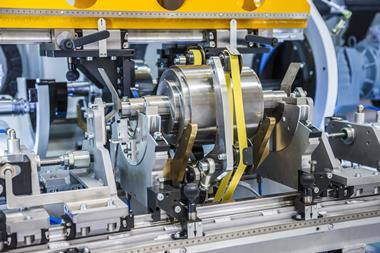As EV makers develop smart-factories, efficient and flexible automation solution for balancing e-drives is at the top of the list, writes Schenck-USA’s Tarek El-Sawaf
 Increasingly better range and output values of electric power units and, above all, the more stringent environmental regulations for internal combustion engines are increasing the demand for vehicles with alternative drive solutions. The automotive industry is rapidly addressing this development by converting its early e-mobility manufacturing plants into more advanced production lines. Factory planners are now dealing with related topics - such as full automation, process integration and digitisation - and are, as a result, designing the first Smart Factories where the future of hybrid and electric vehicles should emerge. In the current transformation phase, planners are striving to optimise flexibility, process performance and automation. E-Mobility Product Line Manager Peter Böhm of Schenck RoTec knows that this also applies to the integration of balancing technology with the development and production environments of e-mobility players: “In almost all discussions we currently have with OEMs and suppliers the desire for an efficient as well as flexible automation solution for balancing e-Drives is at the very top of the list.”
Increasingly better range and output values of electric power units and, above all, the more stringent environmental regulations for internal combustion engines are increasing the demand for vehicles with alternative drive solutions. The automotive industry is rapidly addressing this development by converting its early e-mobility manufacturing plants into more advanced production lines. Factory planners are now dealing with related topics - such as full automation, process integration and digitisation - and are, as a result, designing the first Smart Factories where the future of hybrid and electric vehicles should emerge. In the current transformation phase, planners are striving to optimise flexibility, process performance and automation. E-Mobility Product Line Manager Peter Böhm of Schenck RoTec knows that this also applies to the integration of balancing technology with the development and production environments of e-mobility players: “In almost all discussions we currently have with OEMs and suppliers the desire for an efficient as well as flexible automation solution for balancing e-Drives is at the very top of the list.”
Customised for e-Drive productionThe global system manufacturer Schenck, with world headquarters in Darmstadt Germany has answered this request with the development of the eTENO by an interdisciplinary team of Design Engineers and Consultants. Currently the only balancing system with this unique combination of functions and features, it is specifically geared for use in present and future e-Drive production of suppliers and OEMs. Peter Böhm emphasised that “with the new eTENO, both electric motor manufacturers as well as automotive manufacturers are getting a completely equipped automation solution that delivers highly precise measurement results. It can also be integrated in a flexible manner into development and production settings, and supports the implementation of highly efficient processes.” The two-station machine offers fully automatic balancing and correction of complete electric armatures (rotor, shaft, cage, etc.) with weights of up to 50 kg. Thanks to its modular design and a whole host of different support bearing and balancing types, the eTENO offers maximum flexibility, and features an internal handling system for workpiece changes with short cycles. Its machine design is geared towards short cycle times and its mechanical and electrical design meets all internationally relevant DIN/EN/ISO/UL standards. With the CAB 950 SmartTouch, it also has a premium measuring device from the Schenck RoTec product range on board. In other words, the complete system is quite an innovative overall package. In Peter Böhm’s words: “With close to 100 e-Drives balancing systems word-wide for well-known OEMs and tier-one suppliers, we are the market leader in this E-Mobility segment, and the new eTENO is the very essence of our top technological position in the balancing technology field.”
Increasingly higher revolutionsWith this statement, the Product Manager turns to his colleague Andreas Buschbeck. As manager for Technical Consulting at Schenck RoTec, he and his department are often involved in the development of balancing machines designed for specific branches and products at a very early stage. “In nearly all cases, the initial idea is coming from the customer designing a new rotor and who has to know how its shape and mass will behave in terms of vibrations and how it can be optimized in terms of balancing. We then determine the individual unbalance budget of the rotors. To do this, we evaluate production drawings, calculate the expected unbalance, and identify the design features responsible. Manufacturers use our results to improve the quality and optimise the service life of their rotors,” explains Andreas Buschbeck. During the past years, the Consulting Manager and his team went through this procedure several dozens of times with leading e-Drive manufacturers. The knowledge gained during that time regarding the technical properties of the E-Mobility drives with increasingly higher revolutions– the current goal is to achieve up to 30,000 rpm—and the expectation of the customers in terms of flexibility and efficiency of the balancing processes has been directly incorporated into the development and engineering of the new eTENO.A prime example for this is the interaction between the two main components of the system, the measuring device that is used to determine the size and the position of the unbalance and the processing unit that is used to mechanically correct the unbalance. Here, everything is geared towards maximum precision, best performance, and flexible application. The measuring device can accommodate a wide range of complete e-Drive electric armatures with shaft lengths of up to 500 mm and stack diameters of up to 200 mm in three different supports: Depending on the design of the armature or the request of the customer, it can come with prisms, roller bearings or aerostatic bearings. The armature is accelerated with an intelligent belt drive that releases the rotor when the unbalance speed has been reached, so that it rotates without any interference from to the belt drive during the unbalance measurement. At the end of the measurement, the drive operates again and positions the rotor in the exact balancing position. When taking all optimisations into account, the measurement uncertainties of the unbalance relative to the rotor weight of only < 0,1 µm (0,1 gmm/kg) are achieved! This is an exceptionally high measurement accuracy value.
Vibration-free for maximum service lifeIn the processing unit, the unbalance is almost entirely removed from the e-Drive electric armature, so that it reliably meets two criteria: Nearly vibration-free running and maximum service life. “Since these are the primary goals for balancing rotors,” stresses Product Line Manager Peter Böhm. The eTENO offers users optimum flexibility for this type of unbalance correction as well. With two drills, users can reduce the unbalance of the rotor on the identified position from two sides simultaneously by means of axial drilling. As an alternative, users also have the option to correct the unbalance on the rotor by means of radial drilling or milling or by automatically inserting steel pins in the opposite angular position on the rotor. What is new in terms of balancing technology is that the eTENO does not move the rotor during the axial correction, but rather the drills or the steel pin modules. Reversing the feed movement between the tool and the workpiece as opposed to what was commonly used before offers the major advantage that the individual angular position of any unbalance can be approached simultaneously on each plane for the unbalance. This happens as soon as the measurement process ends—which means while the rotor is still rotating! The result is a considerably shorter cycle time.
The internal workpiece transfer system forms the interface in terms of handling between the measuring and correction unit. It ensures a prompt and, above all, highly precise positional change of the measured electric armature in the clamping system of the processing unit located in the rear as well as short cycle times. The combination of all expertly designed components that come into contact with the workpiece, the easy-to-handle adjustment elements, as well as the tools and clamping devices that are perfectly geared towards the respective rotors results in a highly efficient balancing process with very short secondary processing times. In concrete terms, this means: Depending on the size and the weight of the rotor, cycles of 40 to 100 seconds are possible with the eTENO—for the entire procedure starting with inserting to measuring and balancing down to removing the complete rotors.
Optimum integration thanks to different configurationsThe eTENO can be effortlessly integrated into existing, as well as future development and production environments. This is of particularly high relevance for OEMs as well as suppliers. “We are also benefitting in this regard from our many and long-standing partnerships with leading manufacturers in the automotive, and electrical engineering industries. We are not only familiar with their current process requirements, but also with the branch’s plans and visions for the future. As early as during the conceptual design of our new e-Drive balancing system, we therefore know that we have to leave the manufacturers as much space as possible with the process integration,” explains Product Line Manager Peter Böhm—and draws the viewer’s attention to the possible system variations of the eTENO line.
Here we can see: Shops and departments that are strictly focused on rotor development obtain the eTENO measuring module for balancing technology as a single solution, possibly complemented by a simple correction device with an axial drill unit. The free-standing eTENO with 360-degree accessibility to all functional areas, however, is perfectly geared towards the integration into assembly lines or production cells. Customers who want to have a balancing station as a stand-alone solution can get the eTENO as a complete package in a protective housing in modern design with an externally connected touch screen and a front door that can fully slide open to facilitate loading the rotor by means of robots or loading portals.” Additionally, Schenck RoTec always offers the option to place the measurement station and the balancing station independently from each other. Alternatively, a small eTENO variant that was initially obtained for development work with additional modules for use in Quality Assurance, maintenance, or production can be upgraded. „Thanks to the scalability and the modular design of the eTENO, we also achieve maximum flexibility in terms of process integration,” Emphasises Consulting Manager Andreas Buschbeck is emphasising.
Communication and documentationWhen it comes to control and communication technology, the highly-developed measuring system CAB 950 by Schenck RoTec makes it easy to integrate the eTENO into the customers’ production systems and IT networks. The measuring device is one of Schenck’s top product and features an exceptionally successful software interface with clear icons and intuitive menu guidance, which machine users can use to quickly navigate through the balancing process. The eTENO’s CAB 950 is equally impressive due to the integration of the Siemens SPS S7 (TIA Portal) that allows users to control external loading and unloading devices amongst other things. With the Schenck Computer Aided Balancing Software (CAB), users can also call up all balancing technology data from their office. This helps for example when working on statistical process control and documentation which is a part necessary for quality assurance and customer service.
Like all balancing machines from Schenck RoTec, the new eTENO is also integrated into the comprehensive service and support system that the company uses to ensure the high availability of its systems. In addition to test routines, plausibility checks, and a practically oriented help system, it also offers an online remote diagnosis with teleservice.
How much unbalance is acceptable?It sounds pretty simple really: Regardless of whether they are prototypes or production parts –electric armatures of synchronous, asynchronous, and direct current motors for hybrid or electric vehicles must run vibration-free and achieve a maximum service life. Like many other rotors, they therefore have to be balanced and corrected with high accuracy. However, and this is where it becomes tricky, an electric armature comes as an assembly with all kinds of secondary design structures (rotor, shaft, windings, cages, etc.). Then there are type-specific differences in design, dimension, materials used, and a lot of other things. For many years, the balancing experts of Schenck RoTec Consulting have been involved with engine manufactures in the development of new electric drives. Together with the e-Drive manufacturers, they are therefore able to optimise any electric armature in terms of balancing technology. For the most part, the focus here is on three key questions: How much original unbalance does the rotor have? How much residual unbalance is allowed? And how long is the balancing process allowed to take (including correction)? In light of continuously increasing engine rpms of advanced electric drives and constantly growing centrifugal forces, it becomes increasingly more important to optimise the balance when designing electric armatures.







































